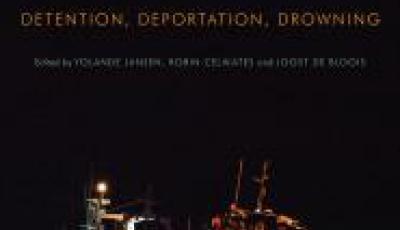Book Review: The Irregularization of Migration in Contemporary Europe: Detention, Deportation, Drowning
Posted:
Time to read:
Guest post by Inga Schwarz, postdoctoral researcher with the research group Cultures of Mobility in Europe (COME) at Albert-Ludwigs-Universität Freiburg, Germany. She is currently working on the postdoctoral research project Il/legalizing Mobility - Legal Categorizations of Unauthorized Migrants in Europe.
Review of The Irregularization of Migration in Contemporary Europe: Detention, Deportation, Drowning, edited by Yolande Jansen, Robin Celikates, and Joost de Bloois (Rowman & Littlefield International, 2014).

The main conceptual innovations of this volume are grouped around three hypotheses. First, that borders have to be seen as complex social relations, working as an ‘apparatus of capture’ (Jeandesboz, Chapter 6). This apparatus excludes some, by keeping specific people out, and includes all, by means of grouping and surveilling everybody through technologies of screening and tracking, capturing all travelling subjects. Second, there is a need to fundamentally reconceptualize the trope ‘citizenship.’ The active constitution of citizen and noncitizen and the flexibility of both categories become obvious at the border, offering freedom to some by excluding it from others:
We have to criticize the modernist framing of freedom in terms of citizenship as such and take into account that ‘the deep inequalities and unfreedoms created on today’s European borders can be addressed only if we thoroughly revise the classical European notions of deliberative, emancipated (‘European’) freedom’ (p. 199).
Third, the conceptualization of ‘systemic violence of border policies’ is developed and confronted with resistant subjectivities and the agency of irregularized migrants. The heavily mediatized ‘border spectacle’ (De Genova, Chapter 1) gives insight into the harsh realities of the systemic violence of European border policies as manifested in pushbacks on the open sea as well as in deportation, detention, and letting people drown. Parallel to this outer manifestation of de facto violence, a system of ‘symbolic violence’ (Jeandesboz, Chapter 6), grouping border crossers through racial profiling, data collection, biometrics, and stigmatization, is also at work. Both systems are confronted by forms of resistance such as movements of unauthorized migrants claiming their rights and strategies of counter-surveillance, mapping the death toll and violent border practices of migration control organizations in the Mediterranean and beyond.
The conceptual points are illustrated throughout the three sections of the edited volume and its contributions by well-known experts in migration and critical border studies. The theoretically informed essays underscore the urgency of the topic as mirrored in alarming detention, deportation, and drowning figures, and the focus on the cultural, political, legal-normative, and economic groundings of border mechanisms which are responsible for normalizing the injustice and violence of European bordering practices. Borders, in this context, aren’t to be seen solely as geographically fixed entities separating the territory of the European Union from neighboring states, but rather as demarcation lines producing criminalization and irregularization of humans at the actual outer geographical borders as well as within and beyond these boundaries. Such demarcation lines are at the center of the volume, describing the segregation of humans based on sociopolitical categorizations such as citizenship (De Genova, Chapter 1; Mezzadra, Chapter 8) and the ascribed differing access to mobility (Bigo, Chapter 4; van Baar, Chapter 5), legal protection (Buckel, Chapter 9), and the employment market (Karakayali, Chapter 3). Categorizations and policing practices in all those areas are fundamentally racist, as many of the contributions highlight, yet the cultural awareness of racism is hindered in Europe for historical reasons (Jansen, Chapter 2).
In opposition to irregularizing mechanisms, the book offers insight into forms of resistance against the symbolic and de facto violence of bordering through migrant activism and political movements which mobilize public attention by offering alternative perspectives on irregularized migration (Dijstelbloem, Chapter 7; Amaya-Castro, Chapter 10; Peeren, Chapter 11). It’s through these accounts of political struggle that de facto violence such as detention, deportation, and letting people drown, as well as the lack of access to basic rights in the everyday lives of unauthorized migrants in Europe, becomes concrete. The symbolic violence of inclusion and exclusion working through sociopolitical categorizations, surveillance, and policing strategies serves as a basis for de facto violence experienced by irregularized migrants. The volume demonstrates that both forms of violence have to be made public to counter the rhetoric of contemporary politics of security and control and to develop joint strategies to hinder the mechanisms of irregularization. As such, it develops and advances critical tools to contribute to these struggles against violent mechanisms of bordering in Europe and the rhetoric legitimizing them.
The Irregularization of Migration in Contemporary Europe thereby extends beyond the conceptual work it contains. The concept of ‘re-/focalization’ (Peeren, Chapter 11) centers the question ‘who sees and what becomes visible (or invisible) through their eyes’ (p. 175), and the focus on resistance against bordering practices lead to the necessity of a joint movement of migratory subjects, academics, and policymakers to overcome the contemporary mechanisms of irregularization of migration. We need to build on the conceptual work done here and follow the experiences and practices of unauthorized migrants through the ‘apparatus of capture’ to make diverse perspectives and experiences of unauthorized im/mobility visible. Only through such empirical work will we be able to offer different angles and approaches to use as tools for critical border thinking which counter the irregularization of migration in contemporary Europe.
Any comments about this post? Get in touch with us! Send us an email, or post a comment here or on Facebook. You can also tweet us.
__________
How to cite this blog post (Harvard style):
Schwarz, I. (2015) Book Review: The Irregularization of Migration in Contemporary Europe: Detention, Deportation, Drowning. Available at: http://bordercriminologies.law.ox.ac.uk/the-irregularization-of-migration/ (Accessed [date]).








